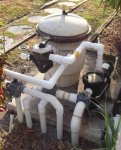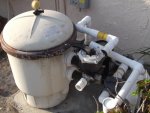So I guess I'm looking for a little reassurance ...
I've got a Pentair Quad 60 DE filter, An Intelliflo VS3050, several 3-way valves, and a bunch of PVC bits on the way. I've done a good bit of irrigation repair, and am comfortable around electrical repairs, but I am beginning to get a little worried on my pending filter/pump replacement.
It does not appear to be all that difficult, though I am certain the collective experience here has developed a good bit of artistic mastery for the process.
My plan is to:
1) Label all my incoming and return plumbing
2) Dry-assemble (no glue) all the bits, taking care to cut each piece as needed (measure twice - cut once)
3) Mark the locations where the joints/fittings should end up
4) disassemble, breath, pray
5) reassemble with glue, starting with the pieces requiring the most manipulation (longer runs with valves, elbows, etc.) to make a few larger sections to be installed.
6) glueing all the larger sections in place/together.
I can tell that 1.5" and 2" PVC isn't gonna want to bend much, so hopefully it will go together without too much grief (ha!)
Any pointers on what may help make this exercise more likely to succeed?
I've got a Pentair Quad 60 DE filter, An Intelliflo VS3050, several 3-way valves, and a bunch of PVC bits on the way. I've done a good bit of irrigation repair, and am comfortable around electrical repairs, but I am beginning to get a little worried on my pending filter/pump replacement.
It does not appear to be all that difficult, though I am certain the collective experience here has developed a good bit of artistic mastery for the process.
My plan is to:
1) Label all my incoming and return plumbing
2) Dry-assemble (no glue) all the bits, taking care to cut each piece as needed (measure twice - cut once)
3) Mark the locations where the joints/fittings should end up
4) disassemble, breath, pray
5) reassemble with glue, starting with the pieces requiring the most manipulation (longer runs with valves, elbows, etc.) to make a few larger sections to be installed.
6) glueing all the larger sections in place/together.
I can tell that 1.5" and 2" PVC isn't gonna want to bend much, so hopefully it will go together without too much grief (ha!)
Any pointers on what may help make this exercise more likely to succeed?




